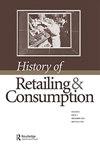Women consumers in urban Soviet Ukraine in the 1920–30s: between ideology and everyday life
Q2 Arts and Humanities
引用次数: 0
Abstract
ABSTRACT In the 1920s the Soviet government decided to focus on women as principal movers in the creation of a new social order based on everyday life. The object of this investigation is to revisit this period in early Soviet history to better understand the interconnection between the motives of the government policymakers and the behaviour of urban women consumers. It focuses on questions about the persistence of the old order alongside the new in the assortment of women's goods, the part played by hand-made items, cosmetics and the individualization of clothes. Special attention is paid to the attitudes of Ukrainian women as the consumers of everyday items and their interaction with Soviet ideology. The elucidation of the role of consumerism with special emphasis on the crucial part played by women provides a novel window into the period and an opportunity to reconstruct social practices and everydayness of the 1920–30s Soviet era.1920–30年代苏联乌克兰城市的女性消费者:意识形态与日常生活之间
摘要20世纪20年代,苏联政府决定将女性作为建立在日常生活基础上的新社会秩序的主要推动者。这项调查的目的是重新审视苏联早期历史上的这一时期,以更好地了解政府决策者的动机与城市女性消费者的行为之间的相互联系。它关注的问题是,在女性商品的分类中,旧秩序与新秩序的持续性,手工制品、化妆品和服装的个性化所起的作用。特别关注乌克兰妇女作为日常用品消费者的态度以及她们与苏联意识形态的互动。对消费主义作用的阐释,特别强调女性所扮演的关键角色,为了解这一时期提供了一个新的窗口,也为重建1920–30年代苏联时代的社会实践和日常生活提供了机会。
本文章由计算机程序翻译,如有差异,请以英文原文为准。
求助全文
约1分钟内获得全文
求助全文
来源期刊

History of Retailing and Consumption
Arts and Humanities-History
CiteScore
0.50
自引率
0.00%
发文量
3
 求助内容:
求助内容: 应助结果提醒方式:
应助结果提醒方式:


